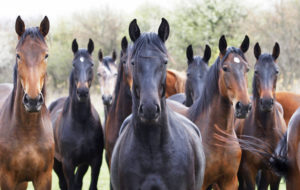If you remember anything about sex differences in biology lessons, it’s likely to be this: males mate as much as possible. They evolve horns to fight off competitors, and beautiful ornaments to win over females. Females, by contrast, focus their energies on choosing the single best male out of all those available. For males, it’s quantity that matters; for females, quality.
As Charles Darwin put it, the female, “with the rarest of exceptions, is less eager than the male”. Males work to “sedulously display their charms before the female”, who “requires to be courted”. This distinction between chaste females and indiscriminately horny males became a central principle of evolutionary theory for much of the 20th century.
Females — the sex defined by production of large gametes, and in most animal species the sex that either lays eggs or gives birth to young — have a physical limit on the rate at which they can produce offspring. Once you’re pregnant, you can’t get more pregnant by having sex again. Males, on the other hand, are not limited in the same way: if they manage to find two sexual partners instead of one, the maximum number of offspring they could have is doubled.
This binary is neat, has instinctive appeal, and has been enormously influential in the wider public imagination. Perhaps most overtly nowadays, it remains popular in the “manosphere”, where men lament that “Chads” are swimming in attention from “hypergamous” women while average Joes get ignored.
Except of course, like most tidy binaries, this one turns out to be an oversimplification. In her latest book, Bitch, zoologist Lucy Cooke addresses misconceptions about the role of females in the animal kingdom. One of the main takeaways is that the that idea females are not naturally slutty is due for an update: today’s cougars “are leading sexually liberated lives, for the benefit of themselves and their family, with no shame attached”.
But why would they do this? Isn’t more than one baby daddy surplus to requirements? Though less obvious, there are evolutionary benefits to playing the field for females as well as for males. Having multiple fathers improves the genetic diversity of a female’s offspring, for instance, and provides insurance in case one is infertile. It can help you trade up in mates, too: if you’re “shacked up with Mr Average”, you might pay a visit to your “neighbour, Mr Fabulous, for some superior genes”.
Cooke tells us how anthropologist Sarah Blaffer Hrdy suggested as early as the 1970s that female philandering could serve a different purpose altogether: protecting offspring. One of the bleaker facts of life is that infanticide is a fairly common practice in our primate cousins, and the animal kingdom more widely, since it “forces the bereaved mother into oestrus, making her readily available for fertilisation” months or years ahead of schedule. Hrdy’s idea, inspired by her observations of Indian langur monkeys, was that by “confusing paternity”, mothers might secure protection, or at least benevolent tolerance, from males who think the baby might be theirs.
The assumption of female monogamy was so strong that for a long time observations to the contrary were written off as anomalies. The idea that female songbirds, for instance — the very symbol of marital bliss — might be sneaking off to find a bit on the side was seen as ludicrous. Perhaps these poor birds were being raped, or else there must be some kind of hormonal malfunction.
Eventually, in the 1990s, these assumptions were overturned, partly thanks to the fact that biologists could now determine paternity through DNA. The conclusion they reached was this: polyandry (that is, when a female mates with multiple males) is much more common, across the whole animal kingdom, than we had previously thought. Many species thought to be monogamous have “affairs” — and often, it is the females that actively seek out these liaisons.
This rewriting of evolutionary theory to include female promiscuity is, of course, catnip to any popular science writer of a feminist bent. As well as in Bitch, this tale features prominently in Angela Saini’s Inferior and Cordelia Fine’s Testosterone Rex — books sold as explicitly feminist reappraisals of scientific consensus. Other topics Cooke covers will appeal to the same audience, from the science of the female orgasm to the lady spiders who dominate in the bedroom by killing and eating their lovers (in response to which, males show counteradaptations “that would make even Christian Grey blush” — oral sex, bondage, and threesomes).
But what’s typically missing from these accounts is context. Because, although Cooke is right to refute the patriarchal falsehood that females only want monogamy, this doesn’t mean we should leap to the opposite conclusion that females seek as many mates as possible; or that there are no systematic differences between the sexual proclivities of females and males. Casual readers of Bitch will likely be left with both these impressions, though.
The benefits of polyandry to females are actually limited: one meta-analysis of 35 species found that overall, it had only a modest effect on the number of offspring produced, and no measurable effect on what proportion of offspring survived. Another meta-analysis, this time focusing on insects, suggests that you can have too much of a good thing: having multiple mates increased females’ fertility, but reduced their lifespan, leading the authors to conclude that the optimum number of mates was probably “intermediate”.
Rigid oversimplification though it may be, as a general rule of thumb Darwin was right: females are often “less eager than the male”, and this divergence can be explained by the different reproductive investments required by each sex. Reading Bitch, you’d be forgiven for thinking this theory was completely debunked, but in fact the logic remains sound, even if we’re now more familiar with the exceptions and caveats.
It’s tempting, if you believe men and women should be equal, to argue that this state of affairs is “natural”. But a key lesson of biology is that if you look closely at any blissful-seeming union, you will find an imperfect alliance, with each party driven by their own interests as well as shared goals. Conflict rages between sexual partners over when to mate, over how promiscuous each of them should be, and how much care each should devote to their shared offspring. The size of new-born mice, for instance, seems to result from a compromise between genes: the fathers’ encourage a developing foetus to grow larger by leaching energy from the mothers, while the mothers’ push them in the other direction.
Another result of conflict between the sexes is that, bluntly, forced and coerced mating is common in the animal kingdom; from insects, to the chickens I’ve spent the last four years studying, to our cousins the orangutans, where one researcher observed almost 90% of copulations to be forced. This is a result of the difference in “choosiness” between the sexes: if on average females are less “choosy” than males, then there will be many situations where they don’t want to mate but a male does.
Perhaps this is why feminist science writers tend to avoid studying conflict between the sexes, even though it has obvious implications for the feminist movement: in this field, there are some inconvenient truths. Popular discussions of sexual conflict and potential implications for human society come almost exclusively from older male biologists, who are predictably (and not always unfairly) accused of insensitivity or suspect motives; a prime example being the spectacularly controversial A Natural History of Rape by Randy Thornhill and Craig Palmer.
In Bitch, we do hear about the nasty and exploitative side of sexual selection, albeit briefly. Cooke’s account of Hrdy’s infanticidal langurs alerts us to the fact that not all female promiscuity follows a “girl power” narrative — it can be the result of something much darker. In her chapter on genital evolution, we learn that the bizarre vaginas of female ducks — which have “helical piping”, “opposing spirals and strange cul-de-sacs” — likely evolved in response to the high rate of forced mating in these birds: their convoluted tracts seem to reduce the chance of fertilisation in such encounters and allow them some control over who fathers their offspring.
But despite the rest of the book being woven with — arguably premised upon — implicit or explicit anthropomorphisation, any such speculations in this case are quickly headed off by a footnote implying that to ask whether rape in human and non-human animals might be related phenomena is to “dangerously” suggest that “a rapist lives inside all human males”. Humans and animals are, in this case, completely different beasts. “This is a very important distinction to make”. It feels as though there’s a lack of curiosity in this kind of popular science book for any aspects of the natural world that don’t fit into the story their audiences want to hear.
It’s no surprise that feminist biologists have little appetite for potentially pessimistic messages from nature. For a start, it’s pretty much the polar opposite of “sex positive”. It’s also at odds with the current trend within feminism to minimise, rather than emphasise, differences between the sexes.
And then, of course, it’s just depressing. Most of us are reluctant to accept fatalistic views of the world, which skate too close for comfort towards potentially disturbing implications for our own species. Readers of popular books on feminism are on average likely to be highly agreeable people, who value pleasantness and see the best in others. They are probably also “low decouplers”, who feel ethically uneasy with “separating is from ought“. According to Cooke, the idea that sexual violence is more than just a man-made aberration is “dangerous” — perhaps even morally repulsive to contemplate.
Feminists are, in general, resistant to the idea that any aspect of sexism could be “natural”, or in male interests to maintain. It’s easier to assume that it’s all a big misunderstanding. But the point of science is to understand the world as it is, not to pick and choose parts to present in a certain light. A blinkered lack of imagination led decades of male biologists to ignore inconvenient evidence and assume females were passively monogamous. Correcting that imbalance shouldn’t mean assembling a contradictory narrative to promote in its place, despite the evidence.
Disclaimer
Some of the posts we share are controversial and we do not necessarily agree with them in the whole extend. Sometimes we agree with the content or part of it but we do not agree with the narration or language. Nevertheless we find them somehow interesting, valuable and/or informative or we share them, because we strongly believe in freedom of speech, free press and journalism. We strongly encourage you to have a critical approach to all the content, do your own research and analysis to build your own opinion.
We would be glad to have your feedback.
Source: UnHerd Read the original article here: https://unherd.com





